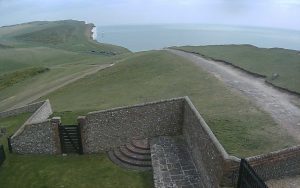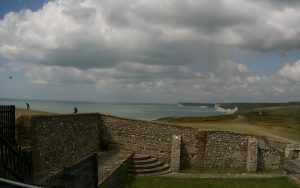One of the most stunning aspects of the Eastbourne Downland is the Heritage Coastline of pure white chalk cliffs. The erosion of these cliffs by the sea is often thought of as a destructive process but it is this erosion which creates and maintains the cliffs’ magnificent whiteness through constantly eroding the old cliff face and revealing the clean white chalk underneath.
The white cliffs of Beachy Head and the Seven Sisters have been eroding for at least 10,000 years, ever since the end of the last Ice Age. The base of the cliff is attacked with tremendous force at high tide as the waves break against the chalk. Shingle is also thrown at the cliff and pockets of air are trapped in the crevices and alternately compressed and decompressed.
These forces combine to erode a notch in the base of the cliff which eventually cannot support the upper parts of the cliff. The cliff is also weakened from the top during the winter as rain water in the soil freezes and expands, pushing the rock apart, and then thaws and runs through the crevices. A section of cliff then tumbles to the beach, creating a temporary defence against the waves until it is broken up and washed away.
One of the key conditions of the management of the Heritage Coast is that it is left undeveloped in order to preserve the landscape value. This means that no sea defences will be built to slow the natural process of erosion, not even to save existing buildings. Belle Toute Lighthouse was moved back from the cliff edge on March 24 1999 in order to save it from an imminent collapse into the sea.
The Heritage Coast recede an estimated average of about ½ -1 metre a year. Occasionally there will be a larger than average cliff fall, such as that on January 10 1999 when up to 6 metres of cliff edge tumbled away, to a depth of 17 metres over a 70 metre long stretch. As global warming continues and sea levels rise the rate of erosion is expected to increase and falls of this size will become increasingly common.
Credit to original source of information located at the following site:http://www.eastbourne.org/tourism/beachyhead/geology.php
Information from the British Geographical Society:
http://www.bgs.ac.uk/esissues/beachy.html
Information from the Applied Geology Research Unit (AGRU) of Brighton University.
http://www.brighton.ac.uk/environment/research/earth_systems/
agru/rocc_chalk_cliffs.htm

